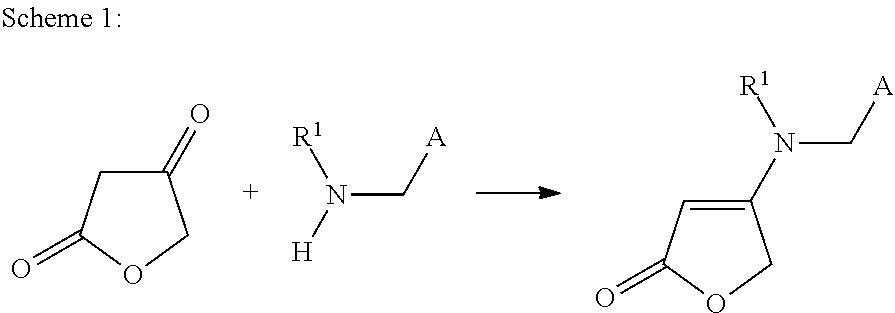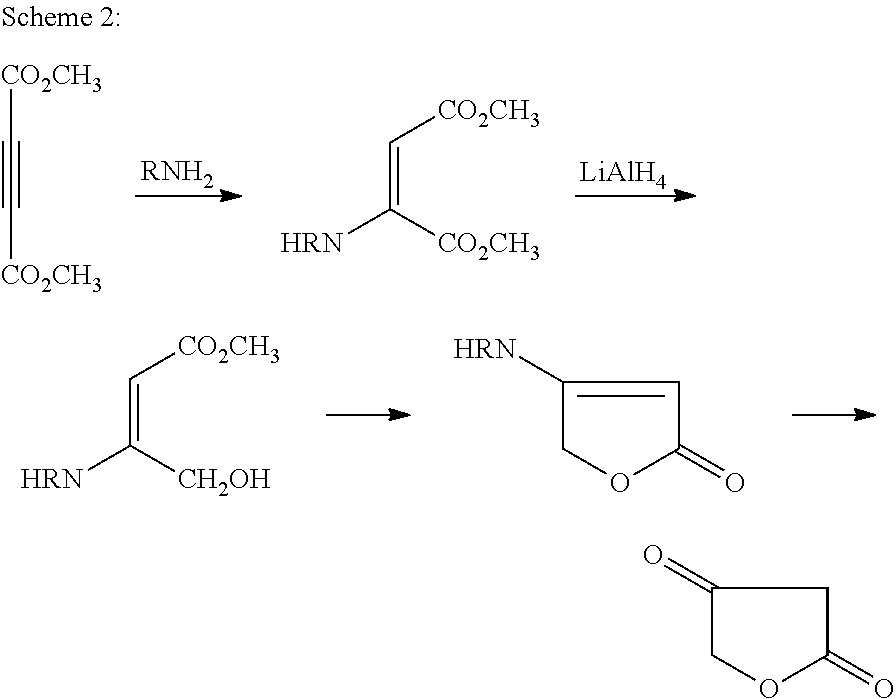Method for preparing 4-aminobut-2-enolides
a technology of aminobutyl enolide and process, applied in the field of process for preparing 4 aminobutyl enolide, can solve the problems of inconvenient and costly preparation relatively unattractive process from an industrial point of view, etc., and achieves high purity, high yield, and simple and inexpensive preparation.
- Summary
- Abstract
- Description
- Claims
- Application Information
AI Technical Summary
Benefits of technology
Problems solved by technology
Method used
Image
Examples
preparation examples
Example 1
[0104]To a suspension of 10.4 g of potassium 4-(ethoxycarbonyl)-5-oxo-2,5-dihydrofuran-3-oxide and 7.5 g of N-[(6-chloropyridin-3-yl)methyl]-2,2-difluoroethylamine in 68 ml of butyronitrile are added, at room temperature, 11.5 g of potassium hydrogensulphate. The mixture is stirred at a temperature of 90 to 95° C. for 3 hours. Subsequently, the mixture is cooled to room temperature, 120 ml of water and 120 ml of dichloromethane are added, the organic phase is removed and the aqueous phase is extracted twice with 120 ml each time of methylene chloride. The combined organic phases are concentrated to dryness. 11.4 g of 4 [[(6-chloropyridin-3-yl)methyl](2,2-difluoroethyl)amino]furan- 2(5H)-one are obtained in a purity of 84% (this corresponds to 92% yield).
example 2
[0105]To a suspension of 5 g of sodium 4-(methoxycarbonyl)-5-oxo-2,5-dihydrofuran-3-oxide and 4.2 g of N-[(6-chloropyridin-3-yl)methyl]-2,2-difluoroethylamine in 35 ml of butyronitrile are added, at room temperature, 7.5 g of potassium hydrogensulphate. The mixture is stirred at a temperature of 90° C. for 3 hours. Subsequently, the mixture is cooled to room temperature and admixed with 60 ml of water and 60 ml of dichloromethane. The organic phase is removed and the aqueous phase is extracted twice with 30 ml each time of methylene chloride. The combined organic phases are concentrated to dryness. 5.95 g of 4-[[(6-chloropyridin-3-yl)methyl](2,2-difluoroethyl)amino]furan-2(5H)-one are obtained in a purity of 89% (this corresponds to 91% yield).
example 3
[0106]To a suspension of 10 g of sodium 4-(methoxycarbonyl)-5-oxo-2,5-dihydrofuran-3-oxide and sodium 4-(ethoxycarbonyl)-5-oxo-2,5-dihydrofuran-3-oxide (ratio 77:23) and 3.5 g of N-[(6-chloropyridin- 3-yl)methyl]methylamine in 35 ml of butyronitrile are added, at room temperature, 7.5 g of potassium hydrogensulphate. The mixture is stirred at a temperature of 90° C. for 3 hours. Subsequently, the mixture is cooled to room temperature and the solvent is removed completely. The residue is admixed with 50 ml of water and extracted twice with 30 ml each time of dichloromethane. The combined organic phases are concentrated to dryness. 4.7 g of 4-[[(6-chloropyridin- 3-yl)methyl]methylamino]furan-2(5H)-one are obtained in a purity of 95% (this corresponds to 82% yield).
PUM
| Property | Measurement | Unit |
|---|---|---|
| boiling points | aaaaa | aaaaa |
| boiling points | aaaaa | aaaaa |
| temperatures | aaaaa | aaaaa |
Abstract
Description
Claims
Application Information
 Login to View More
Login to View More - R&D
- Intellectual Property
- Life Sciences
- Materials
- Tech Scout
- Unparalleled Data Quality
- Higher Quality Content
- 60% Fewer Hallucinations
Browse by: Latest US Patents, China's latest patents, Technical Efficacy Thesaurus, Application Domain, Technology Topic, Popular Technical Reports.
© 2025 PatSnap. All rights reserved.Legal|Privacy policy|Modern Slavery Act Transparency Statement|Sitemap|About US| Contact US: help@patsnap.com



